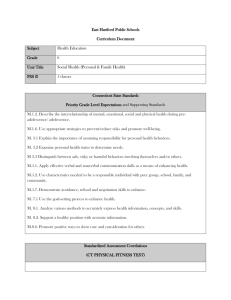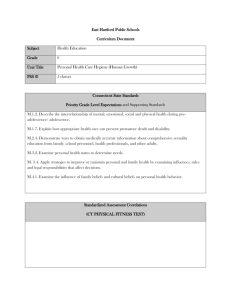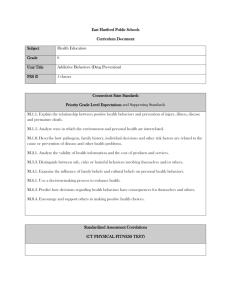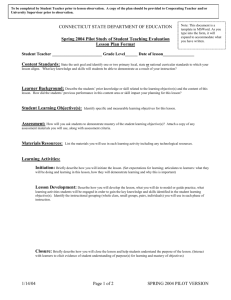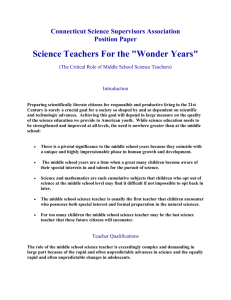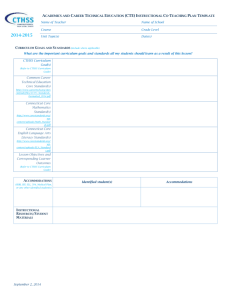Unit Plan & Curriculum - East Hartford Public Schools
advertisement
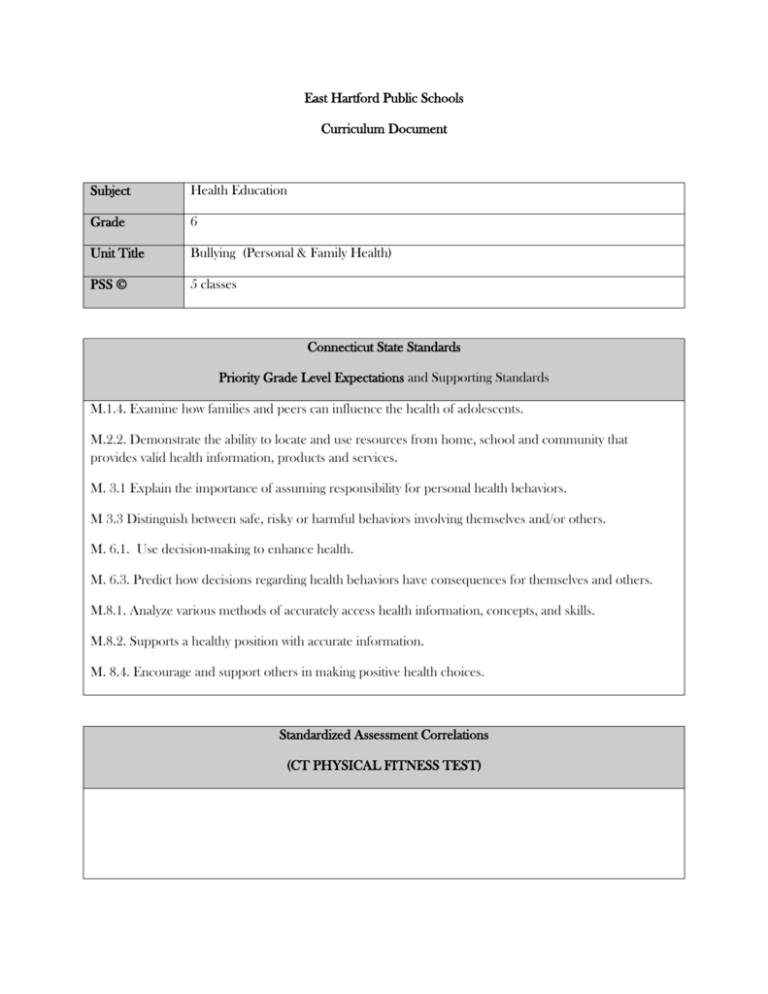
East Hartford Public Schools Curriculum Document Subject Health Education Grade 6 Unit Title Bullying (Personal & Family Health) PSS © 5 classes Connecticut State Standards Priority Grade Level Expectations and Supporting Standards M.1.4. Examine how families and peers can influence the health of adolescents. M.2.2. Demonstrate the ability to locate and use resources from home, school and community that provides valid health information, products and services. M. 3.1 Explain the importance of assuming responsibility for personal health behaviors. M 3.3 Distinguish between safe, risky or harmful behaviors involving themselves and/or others. M. 6.1. Use decision-making to enhance health. M. 6.3. Predict how decisions regarding health behaviors have consequences for themselves and others. M.8.1. Analyze various methods of accurately access health information, concepts, and skills. M.8.2. Supports a healthy position with accurate information. M. 8.4. Encourage and support others in making positive health choices. Standardized Assessment Correlations (CT PHYSICAL FITNESS TEST) Subject Health Education Grade 6 Unit Title Bullying (Personal & Family Health) PSS © 5 classes Big Ideas Essential Questions Bullying can have a major influence on society. 1. How does bullying effect school climate? 2. How and where can I seek help? 3. What is the appropriate way to respond to bullying? Concepts Skills (what students need to know) (what students need to be able to do) Bloom’s Level How to develop and demonstrate a sense of power. Address interrelationships and the complexity of influences. How to advocate for needs and rights of others. Encourage others to make healthful choices. 2-3 How to advocate for a healthy social environment. Demonstrate passion and conviction. 1-2 When and why to get help. How to identify support systems. Identify the type of help available and demonstrate the ability to access appropriate community resources. Assessments 3 2-3 Pre-Assessment “Dipsticks” (Informal Progress Monitoring) As determined by: Collins Writing Types 1-5 Projects & presentations Homework Essays Note checks & Graphic Organizers Data Discussion (CFA’s) (Teachers) True/False Unit Content Open-ended response Symbols/charts prior knowledge Post-Assessment True/False Unit Content Open-ended response Symbols/charts prior knowledge Assessment Guides (Rubrics) To be attached with Unit Assessment. Instructional Planning REQUIRED Resources and Materials Recommended Resources and Materials Comprehensive School Health Education. Healthy & Balanced Living Curriculum Framework. Connecticut State Department of Education. 2006. Instructional Drolet, J. & Wycoff-Horn, M. Health Education Health Education Assessment Project. Curriculum Framework – State of Connecticut. 2003. Education. 2006. Teaching Strategies – for Elementary and Middle Grades. American Association for Health Technological www.healthteacher.com www.kidshealth.org Instructional Planning (continued) Effective Teaching Strategies Enrichment, Intervention, and Differentiation 1-5-6 East Hartford Public Schools Curriculum Document Subject Health Education Grade 6 Unit Title Family/Community Health (Personal & Family Health) PSS © 5 classes Connecticut State Standards Priority Grade Level Expectations and Supporting Standards M.1.4. Examine how families and peers can influence the health of adolescents. M. 3.4. Apply strategies to improve or maintain personal and family health by examining influences, rules and legal responsibilities that affect decisions. M.4.1. Examine the influence of family beliefs and cultural beliefs on personal health behavior. M.5.6. Use communication skills to build and maintain healthy relationships. M.6.2. Describe and analyze how health-related decisions are influenced by using resources from family, school, and community. M.8.1. Analyze various methods of accurately access health information, concepts, and skills. M.8.2. Supports a healthy position with accurate information. M. 8.4. Encourage and support others in making positive health choices. Standardized Assessment Correlations (CT PHYSICAL FITNESS TEST) Subject Health Education Grade 6 Unit Title Family/Community Health (Personal & Family Health) PSS © 5 classes Big Ideas Relationships with family and community can impact overall heath. Essential Questions 1. How do family members and peers affect our personal behaviors? 2. How can I embrace diversity? (culture, disabilities, race/ethnicity, sexuality) 3. How can I promote PRIDE within myself, family, and community? Concepts Skills (what students need to know) (what students need to be able to do) How to develop and demonstrate a sense of Demonstrate communication among power. individuals. How to build and maintain healthy friendships. Address interrelationships and the complexity of influences. Ways to communicate respect for diversity (i.e. mental and physical disabilities, culture, etc.) Demonstrate passion and conviction. Bloom’s Level 1-2 2 3 Assessments Pre-Assessment “Dipsticks” (Informal Progress Monitoring) As determined by: True/False Unit Content Open-ended response Symbols/charts prior knowledge Collins Writing Types 1-5 Projects & presentations Homework Essays Note checks & Graphic Organizers Data Discussion (CFA’s) (Teachers) Post-Assessment True/False Unit Content Open-ended response Symbols/charts prior knowledge Assessment Guides (Rubrics) To be attached with Unit Assessment. Instructional Planning REQUIRED Resources and Materials Recommended Resources and Materials Comprehensive School Health Education. Healthy & Balanced Living Curriculum Framework. Connecticut State Department of Education. 2006. Instructional Drolet, J. & Wycoff-Horn, M. Health Education Health Education Assessment Project. Curriculum Framework – State of Connecticut. 2003. Education. 2006. Teaching Strategies – for Elementary and Middle Grades. American Association for Health Technological www.healthteacher.com www.kidshealth.org Instructional Planning (continued) Effective Teaching Strategies 3-5-6 Enrichment, Intervention, and Differentiation
